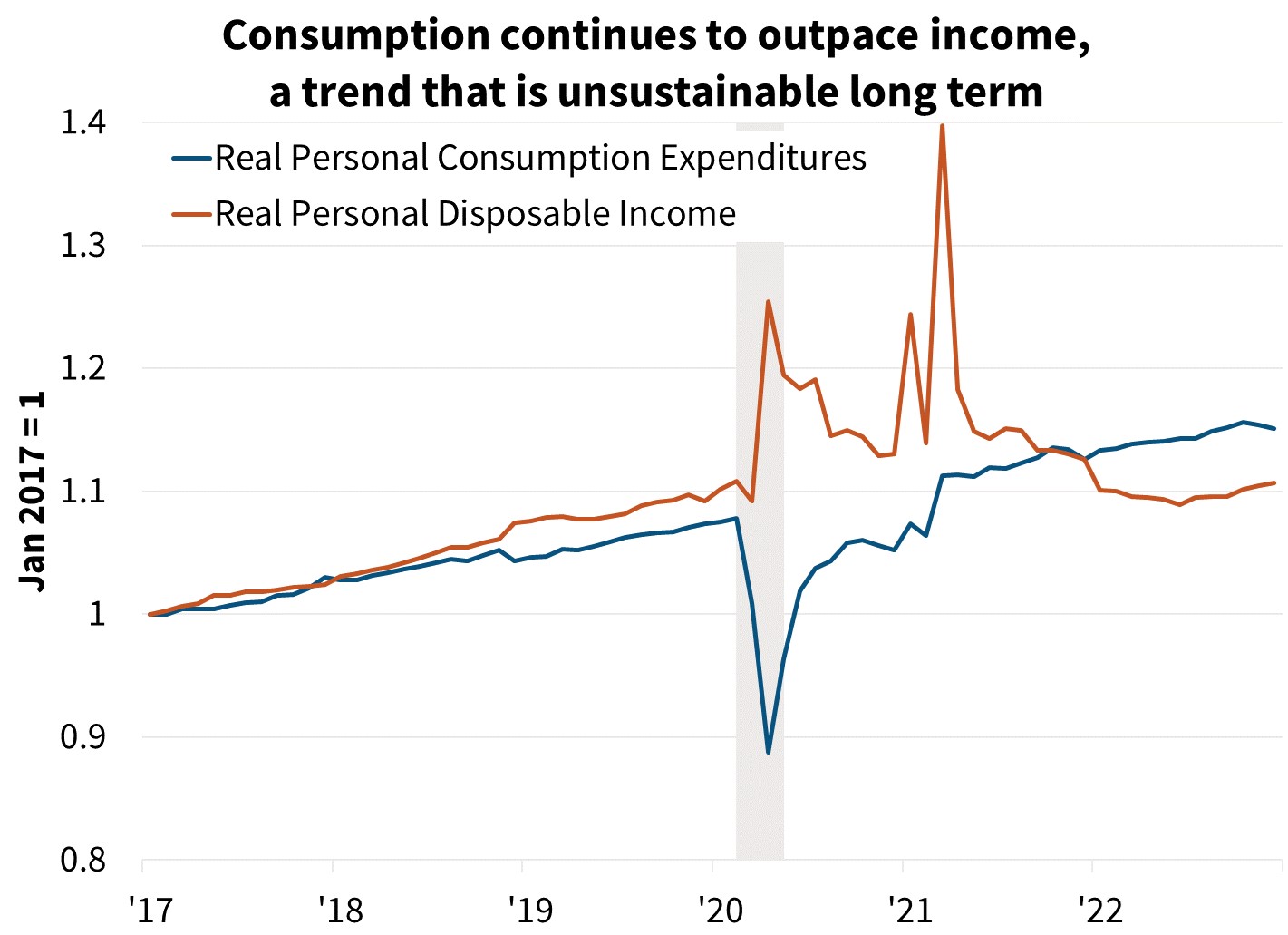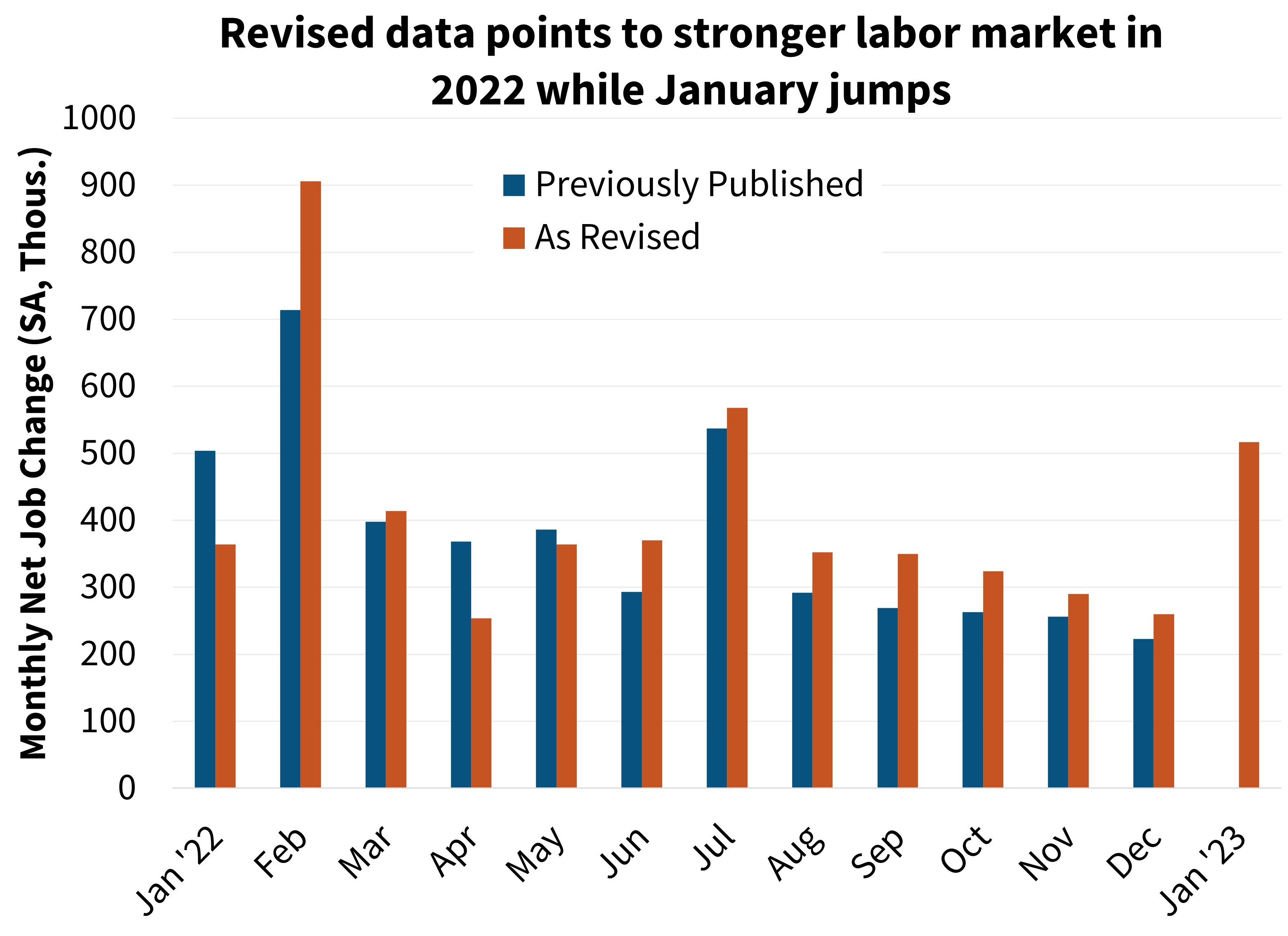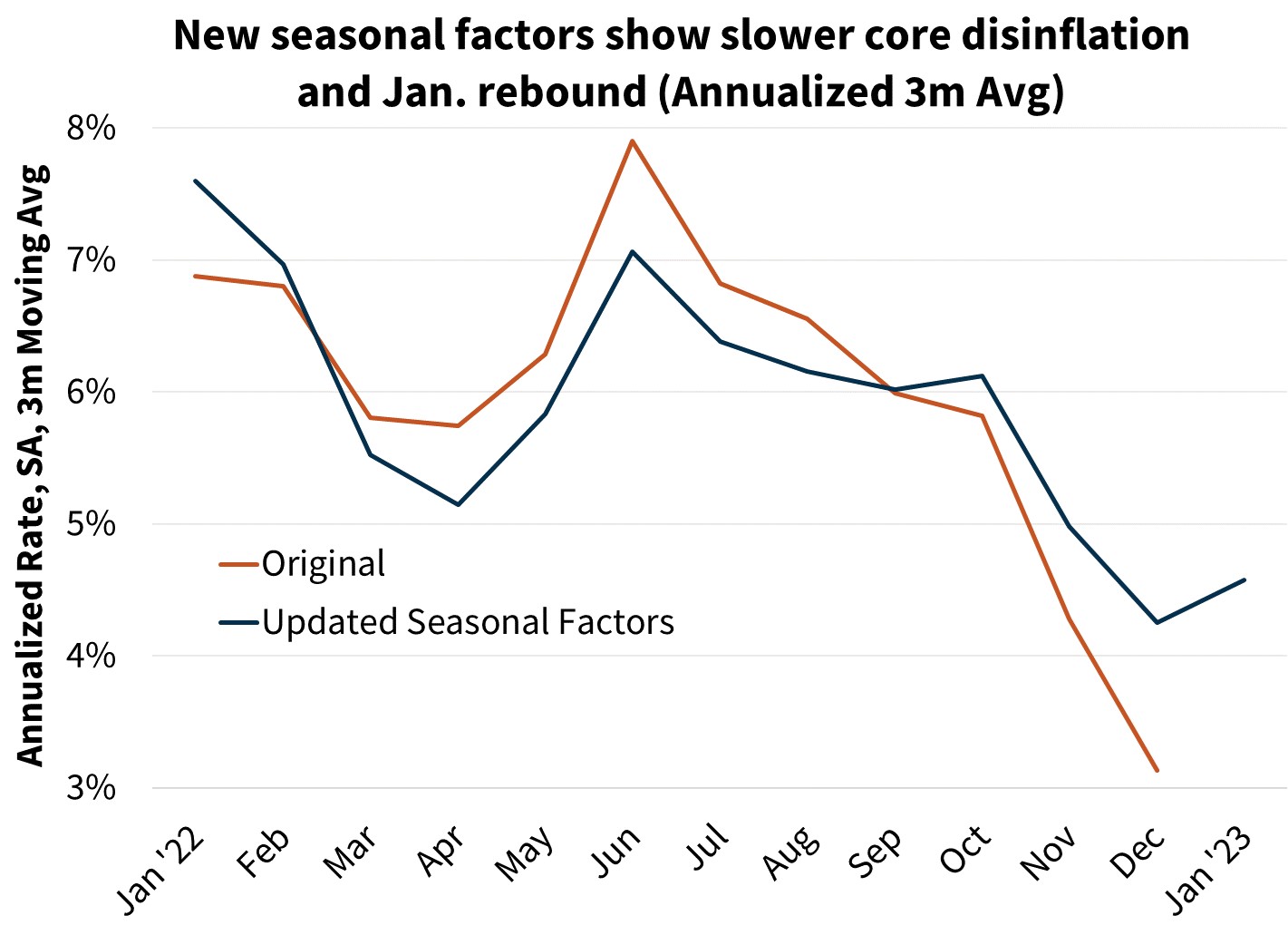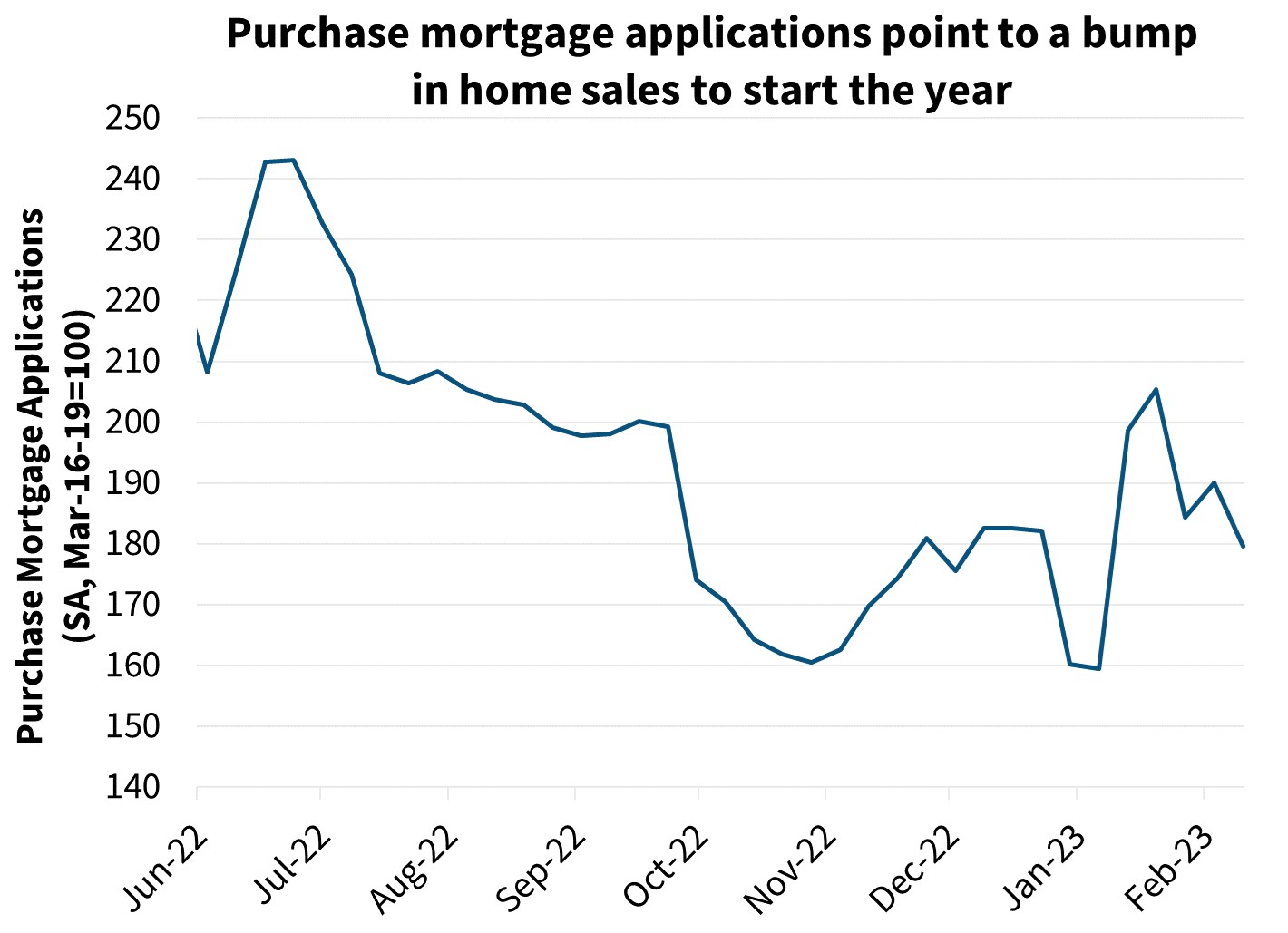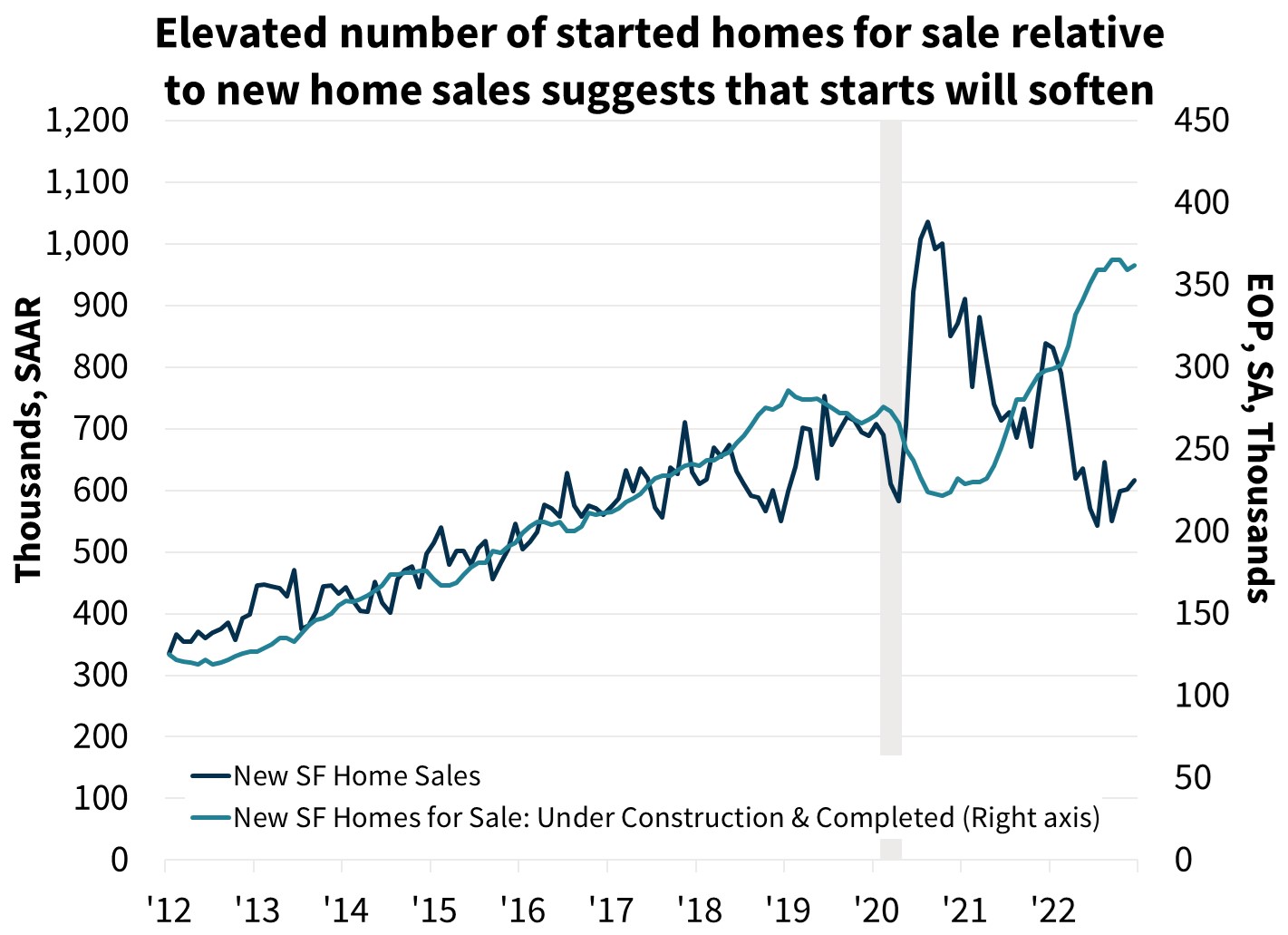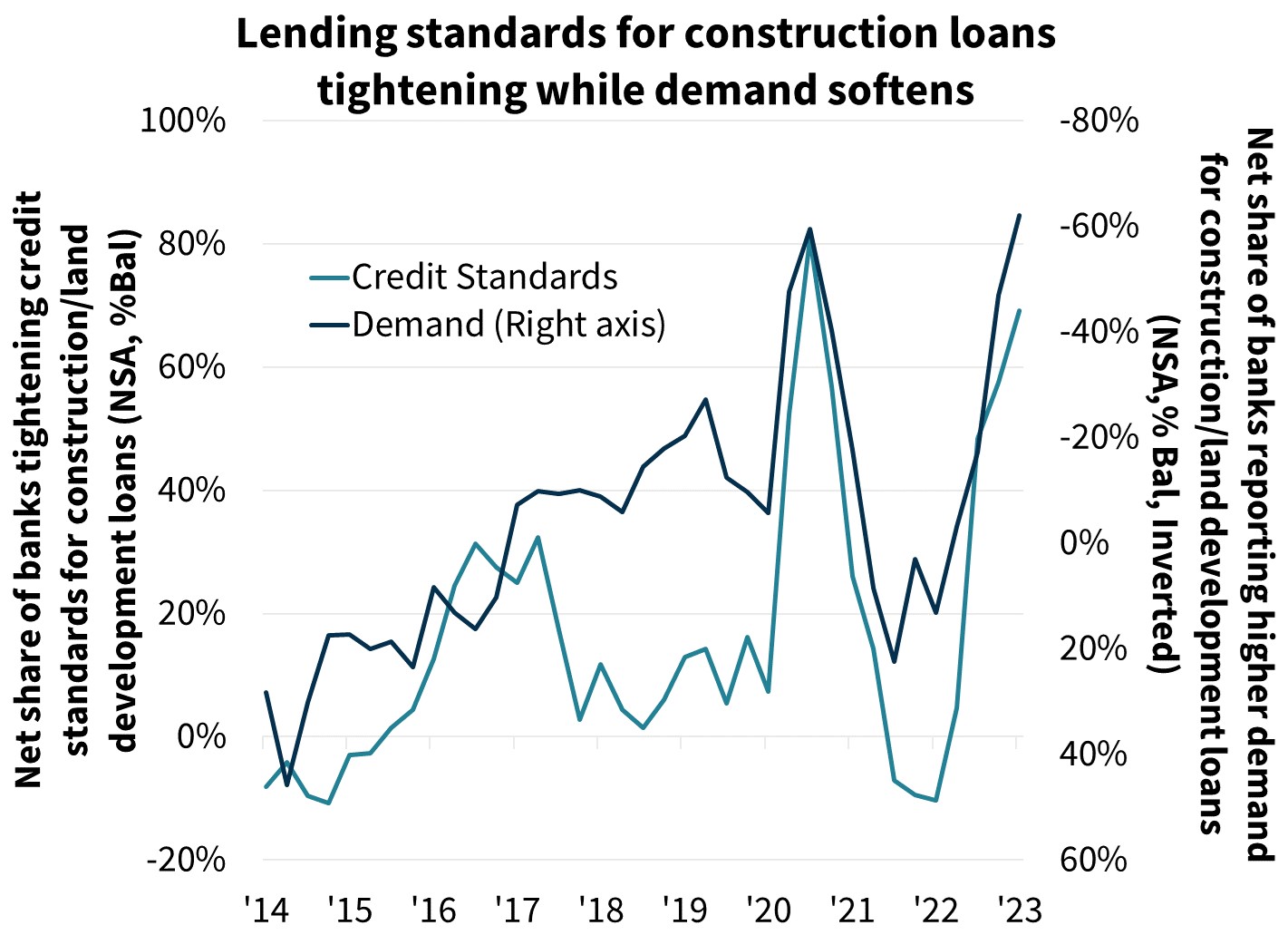Economy and Housing Begin Year on Strong Footing, But It’s Not Expected to Last
A slew of recent data releases along with significant historical revisions point to both an economy and housing market that entered 2023 on a stronger footing than previously anticipated. The past weeks have seen a blowout January employment report, large upward revisions to recent inflation data, and stronger-than-expected measures for retail sales and manufacturing output. While we believe there are reasons to partially discount the strength of many of these figures due to irregularities with seasonal adjustments around the holiday period as well as abnormal weather, it increasingly appears unlikely that a recession will begin in Q1 2023. Relatedly, this stronger set of data strengthens the case for the Federal Reserve to maintain a tighter policy stance for longer; in fact, interest rate futures markets have adjusted accordingly and, as of this writing, point to a terminal fed funds rate of 5.5 percent by mid-year 2023, with only a single cut by the end of 2023.
Still, we expect that it is only a matter of time until the economy enters a recession. We view a soft landing, though possible, as unlikely. Fundamentally, personal consumption remains at a level that is unsustainably high relative to incomes, pointing to eventual consumer spending retrenchment. Monetary aggregates are negative on an annual basis, a phenomenon that has only occurred around recessions in the past, and the labor market is likely too tight to significantly slow inflation in the core services less shelter category that the Fed has made its main focus. Additionally, a wide range of leading indicators such as the Conference Board Leading Economic Index® (LEI) and an increasingly inverted yield curve still point toward contraction. Therefore, our baseline forecast now calls for a modest recession beginning in the second quarter of 2023.
We have slightly revised upward our 2023 real gross domestic product (GDP) forecast by one-tenth of a point to a decline of 0.5 percent on a Q4/Q4 basis. We believe this will be followed by growth of 1.8 percent in 2024, a downward revision of one-tenth.
It should be noted that many of the aforementioned data releases (and their historical revisions) occurred following the completion of our forecast process. As such, as of this writing, we believe there to be significant upside risk to our Q1 2023 GDP forecast. While a slowdown in inventory investment following its Q4 2022 surge will likely still drag on growth to start the year, consumer spending is probably stronger than we had forecast following the January retail sales and labor reports. Additionally, historical Consumer Price Index (CPI) data was revised significantly higher for recent months due to updated seasonal adjustment factors, leading to stronger momentum currently, meaning that near-term annual inflation rates are likely to be higher than our forecast values (a CPI in low-to-mid-6 percent range for Q1 2023 compared to our published 5.4 percent).
In housing, we expect home sales to remain subdued for the remainder of 2023, though recent mortgage application data came in stronger than expected, suggesting the year will likely start off with a larger bump in housing activity as well. Combined with a lower mortgage rate outlook compared to our January forecast, this has led to an upward revision to our home sales outlook in the near term (though interest rates have trended upwards since our forecast). We now forecast total home sales in 2023 to be 4.67 million units, up from a previous forecast of 4.52 million. Still, this would be the slowest annual pace of sales since 2011. We forecast a partial rebound in 2024 to follow, with total sales rising 9.6 percent to 5.12 million units as the broader economy recovers. This is a pace still well below recent years, however, as affordability challenges remain elevated. Our outlook for overall single-family mortgage originations in 2023 is $1.69 trillion and $2.03 trillion in 2024, a substantial contraction from our estimated 2022 volume of $2.36 trillion.
Labor Market (Temporarily?) Surprises to the Upside
January employment gains vastly exceeded both our and consensus expectations with 517,000 jobs being added, a strong acceleration from December’s figure and reversing a five-month streak of deceleration. Additionally, as a result of the Bureau of Labor Statistics’ (BLS) annual benchmarking process, gains from June to December were revised upward by a cumulative 381,000 jobs, indicating the labor market entered 2023 with more momentum than previously thought.
Some of the strength is consistent with easing financial market conditions to start the year as well, a likely one-time jump in disposable incomes stemming from the previous pullback in gasoline prices, and annual inflation adjustments to social security benefits and tax brackets. However, we have decided to partially discount the strength of this report in our forecast. While this strength presents upside near-term risk to our growth outlook, we suspect that some of the gains are due to oddities around abnormally warm weather over much of the month as well as the difficulties in determining the correct seasonal adjustments around the holiday period. Given ongoing disruptions to traditional seasonal patterns of both consumption and hiring/layoffs in the aftermath of the pandemic, we think at least some of the reported January strength is attributable to seasonality quirks. It should be noted that the ADP alternative measure of payroll employment showed only a gain of 106,000 over the month, and continuing unemployment claims are still trending modestly higher. Additionally, the employment measures in the Institute for Supply Management (ISM) and National Federation of Independent Businesses’ (NFIB) surveys are also pointing to subdued hiring patterns.
Additionally, while several of the January data releases have been stronger than expected, the quarterly figures and three-month moving averages paint a more modest picture. Headline GDP growth in Q4 2022 was modestly higher than we had expected, coming in at 2.9 percent. However, this was due almost entirely to a surge in inventory investment (which is likely to reverse in Q1) and a fall in imports. Real final sales to private domestic purchasers (consumption and private fixed investment), which is more indicative of the underlying growth trend, came in at a meager 0.2 percent annualized growth rate. This was the slowest since the onset of the pandemic. Further, as measured by the Federal Reserve Board’s industrial production report, despite a bump up in January, manufacturing output has hovered near recessionary levels and touched the lowest level since October 2021 in December. Finally, the Conference Board’s LEI continues to flash warning signs and is down 3.8 percent over the six months ending in December.
New CPI Seasonal Adjustments Show Prices are Stickier than Previously Thought
The January CPI report accelerated on a month-over-month basis, rising 0.5 percent, as the drag from energy prices over the past two months partially reversed. Core CPI also came in somewhat hot, rising 0.4 percent over the month and 5.6 percent over the year. While much of the inflation measure can be attributed to surging prices for shelter, this component reliably lags measures in asking rents and housing prices. Current price gains are therefore reflective of market changes from last year and given the slowdown in asking rents over the past half year, we expect the shelter component of the CPI to slow down as well in the back half of 2023.
Still, inflation less shelter was stronger than expected as many goods items reaccelerated, such as home furnishings and apparel, and the Manheim Index, a widely tracked measure of wholesale used car prices that tends to lead the CPI measure by a month, rose in its most recent release. Non-energy and shelter services, a component the Fed has explicitly stated it is following as a measure of underlying trend inflationary pressure, also remained well above what is consistent with a 2-percent target.
In addition, the BLS updated the seasonal adjustment factors and weights used to calculate the CPI, which have affected both the January report and historical data. While the data still shows significant deceleration from last year’s peak, the slowdown over the past several months is now less than initially reported. While supply chains remain a factor – the New York Fed’s Global Supply Chain Index is around one standard deviation above typical supply chain pressures – conditions have generally improved and are no longer a major driver of inflationary pressure. Thus, the fact that core prices (even when excluding shelter) continue rising at a strong clip indicates that demand is sufficient to support such price hikes. Again, as with the labor report, this presents upside risk to our near-term growth forecast as well as interest rates.
If the labor market and inflation measures remain stronger for longer than anticipated, it raises the likelihood that the Fed will reach a higher terminal rate and/or keep rates higher for longer than currently in our forecast. Therefore, any upside risk to economic growth and associated inflationary pressures in the near term could lead to higher interest rates later in 2023, with impacts on home sales and prices. Additionally, the more aggressively the Federal Reserve continues to raise its Fed Funds target, the higher the possibility of a weak point somewhere in the global financial system eventually breaking under the pressure. If that were to occur, a more severe downturn than we are forecasting becomes a possibility later in 2023 or 2024. We currently expect the Fed to hike by 25 basis points each at its March and May meetings, though market expectations have shifted to expecting an additional hike at the July meeting.
Housing Enjoys a (Temporary?) Bump to Start the Year Too
Existing home sales fell 1.5 percent in December to a seasonally adjusted annualized rate (SAAR) of 4.0 million units, the slowest pace since 2010. However, more recent incoming data on mortgage applications and pending sales (which lead closings on average by about 30-45 days) suggest that housing in 2023 started off with a meaningful bounce from December’s low. Mortgage rates in January were around 100 basis points below their November peak, and we expect that many would-be homebuyers who may have been waiting on the sidelines took advantage of the drop in mortgage rates to reenter the housing market. The most recent mortgage application data following the completion of our forecast came in stronger than we expected, pointing to some upside risk to our near-term home sales forecast, though we continue to expect that the bump in housing activity to start the year will prove to be temporary. Affordability constraints and tight inventories will continue to limit home sales and the 10-year Treasury has moved up meaningfully since the completion of our interest rate forecast, suggesting mortgage rates will soon be back on the rise. Meanwhile, many existing homeowners have mortgages with rates that are well below current market rates, which acts as a strong disincentive to move. We expect this “lock in” effect to continue to keep home sales subdued for the foreseeable future as long as mortgage rates remain in their current range. While the fast decline in 2022 home sales likely will not be repeated this year, we expect the pace of existing sales to remain soft, totaling around 4.1 million units for the year, a level similar to the annual pace that occurred in 2008-2011 period.
Single-family housing starts jumped in December by 11.3 percent to a SAAR of 909,000 units. While this coincides with the pullback in mortgage rates, we expect starts to fall back significantly in the coming months. This series tends to be volatile to begin with and there is added difficulty with interpreting the seasonal adjustments around the holiday season; additionally, we believe that some of the jump in December is likely a rebound following weather events in prior months. In contrast to starts, single-family permits fell 6.4 percent over the month, which we see as being more indicative of the underlying trend.
Fundamentally, there continues to be an elevated number of homes under construction or completed that are for sale relative to the recent sales pace. Therefore, we expect homebuilders to slow the pace of new starts in coming months as they turn to generating sales by working through their current inventories. This heightened level of inventory is partly why we expect new home sales to remain resilient relative to existing home sales. Builders entered last year’s mortgage rate rise with elevated operating margins and we expect the continued use of mortgage rate buydowns and other incentives to attract would-be buyers. Given homebuilders will be able to draw from their already started inventories, we are forecasting housing starts to decline relative to the new home sales pace over this next year. We project single family starts for 2023 to be 24 percent less than 2022 totals but new single-family sales to decline only 5.4 percent for the year.
Unlike single-family housing construction, which tends to lead turns in the business cycle, multifamily starts have historically been slower to adjust due to the longer project lead times. While multifamily starts have surprised to the upside over recent months, we are forecasting a meaningful slowdown this year in light of weak rent growth, upwardly drifting vacancy rates, and tighter credit conditions on construction lending. The Federal Reserve’s Q1 Senior Loan Officer Survey, a measure of bank lending standards, showed both a high net percent of banks tightening multifamily land development and construction loan standards while also reporting falloffs in demand. We project that this dynamic will be reflected in multifamily housing starts in the upcoming months.
Originations Forecast Revised Modestly Upward
We have upgraded our view of purchase originations this month consistent with an upgraded housing outlook stemming from lower rates. In particular, we now expect 2023 purchase volumes to be $1.3 trillion, up $38 billion from last month. We expect purchases to rise to $1.5 trillion in 2024 as the housing market recovers from the predicted recession, an increase of 10 percent from 2023 and an upgrade of $32 billion from our prior forecast.
Our lower rates expectation also drove upward revisions to our forecast of refinance originations this month. We now expect refinance originations to be $367 billion in 2023 and $577 billion in 2024, representing upward revisions of $12 billion and $32 billion, respectively. We have seen application activity trending upward recently (in particular, please see recent commentary from the Fannie Mae Refinance Application-Level Index, or RALI) as rates have fallen around 100 basis points from their highs set in October and November of last year; this positive momentum also contributed to upward revisions this month.
Economic & Strategic Research (ESR) Group
February 16, 2023
For a snapshot of macroeconomic and housing data between the monthly forecasts, please read ESR’s Economic and Housing Weekly Notes.
Data sources for charts: Bureau of Economic Analysis, Bureau of Labor Statistics, Census, Bureau, Federal Reserve, Fannie Mae
Opinions, analyses, estimates, forecasts and other views of Fannie Mae's Economic & Strategic Research (ESR) Group included in these materials should not be construed as indicating Fannie Mae's business prospects or expected results, are based on a number of assumptions, and are subject to change without notice. How this information affects Fannie Mae will depend on many factors. Although the ESR group bases its opinions, analyses, estimates, forecasts and other views on information it considers reliable, it does not guarantee that the information provided in these materials is accurate, current or suitable for any particular purpose. Changes in the assumptions or the information underlying these views could produce materially different results. The analyses, opinions, estimates, forecasts and other views published by the ESR group represent the views of that group as of the date indicated and do not necessarily represent the views of Fannie Mae or its management.
ESR Macroeconomic Forecast Team
- Doug Duncan, SVP and Chief Economist
- Mark Palim, VP and Deputy Chief Economist
- Eric Brescia, Economics Manager
- Nick Embrey, Economist
- Nathaniel Drake, Economic Analyst
- Richard Goyette, Economic Analyst
